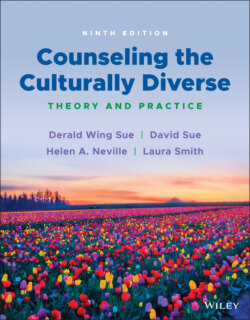Читать книгу Counseling the Culturally Diverse - Laura Smith L. - Страница 35
SUMMARY
ОглавлениеStudents who take a course on multicultural counseling and mental health issues have almost universally felt both positive and negative feelings that affect their ability to learn about diversity issues. Those from marginalized groups often feel validated by the content while majority group members often feel a range of emotions like defensiveness, anxiety, anger, and guilt. It is important not to allow these nested or embedded emotions to go unacknowledged, or to avoid exploring the psychological meanings they may have for trainees. The journey to becoming culturally competent therapists is filled with obstacles to self‐exploration, to understanding oneself as a racial/cultural being, and to understanding the worldview of those who differ from others in terms of race, gender, ethnicity, sexual orientation, and other sociodemographic dimensions. The subject matter in this book requires students to explore their biases and prejudices, a task that often evokes strong resistance from both majority and oppressed group members.
It is important to recognize personal resistance to the material, to explore its meaning, and to learn about yourself and others. Sometimes, what is revealed about you may prove disturbing, but having the courage to continue is necessary to becoming a culturally competent counselor or therapist. Recognizing the manifestation and hidden meanings of resistance is one of the first priorities of multicultural training for both trainees and trainers. For trainees, it is finding the courage to confront their own fears and apprehensions, to work through the powerful emotions they are likely to experience, to explore what these feelings mean for them as racial/cultural beings, to achieve new insights about themselves, and to develop multicultural skills and behaviors in their personal lives and as mental health professionals. For trainers, it means understanding the nature of trainee resistance, creating a safe but challenging environment for self‐exploration, and using intervention strategies that facilitate difficult dialogues on race, gender, sexual orientation, and other sociodemographic dimensions. This chapter is specifically written to help readers understand and overcome their emotive reactions to the substance of the text and the course they are about to take.
